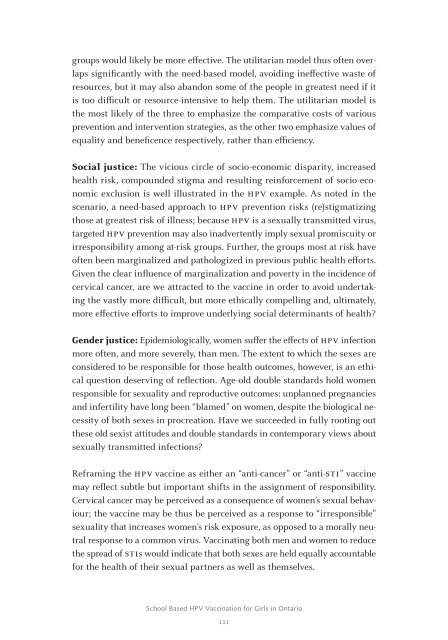PoPulationand Public HealtH etHics
PoPulationand Public HealtH etHics
PoPulationand Public HealtH etHics
You also want an ePaper? Increase the reach of your titles
YUMPU automatically turns print PDFs into web optimized ePapers that Google loves.
groups would likely be more effective. The utilitarian model thus often overlaps<br />
significantly with the need-based model, avoiding ineffective waste of<br />
resources, but it may also abandon some of the people in greatest need if it<br />
is too difficult or resource-intensive to help them. The utilitarian model is<br />
the most likely of the three to emphasize the comparative costs of various<br />
prevention and intervention strategies, as the other two emphasize values of<br />
equality and beneficence respectively, rather than efficiency.<br />
Social justice: The vicious circle of socio-economic disparity, increased<br />
health risk, compounded stigma and resulting reinforcement of socio-economic<br />
exclusion is well illustrated in the HPV example. As noted in the<br />
scenario, a need-based approach to HPV prevention risks (re)stigmatizing<br />
those at greatest risk of illness; because HPV is a sexually transmitted virus,<br />
targeted HPV prevention may also inadvertently imply sexual promiscuity or<br />
irresponsibility among at-risk groups. Further, the groups most at risk have<br />
often been marginalized and pathologized in previous public health efforts.<br />
Given the clear influence of marginalization and poverty in the incidence of<br />
cervical cancer, are we attracted to the vaccine in order to avoid undertaking<br />
the vastly more difficult, but more ethically compelling and, ultimately,<br />
more effective efforts to improve underlying social determinants of health?<br />
Gender justice: Epidemiologically, women suffer the effects of HPV infection<br />
more often, and more severely, than men. The extent to which the sexes are<br />
considered to be responsible for those health outcomes, however, is an ethical<br />
question deserving of reflection. Age-old double standards hold women<br />
responsible for sexuality and reproductive outcomes: unplanned pregnancies<br />
and infertility have long been “blamed” on women, despite the biological necessity<br />
of both sexes in procreation. Have we succeeded in fully rooting out<br />
these old sexist attitudes and double standards in contemporary views about<br />
sexually transmitted infections?<br />
Reframing the HPV vaccine as either an “anti-cancer” or “anti-stI” vaccine<br />
may reflect subtle but important shifts in the assignment of responsibility.<br />
Cervical cancer may be perceived as a consequence of women’s sexual behaviour;<br />
the vaccine may be thus be perceived as a response to “irresponsible”<br />
sexuality that increases women’s risk exposure, as opposed to a morally neutral<br />
response to a common virus. Vaccinating both men and women to reduce<br />
the spread of stIs would indicate that both sexes are held equally accountable<br />
for the health of their sexual partners as well as themselves.<br />
School Based HPV Vaccination for Girls in Ontario<br />
111
















